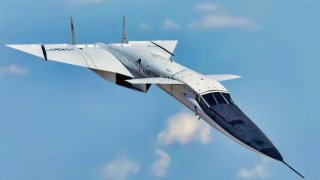XB-70 Valkyrie: The Supersonic Bomber Russia Made Obsolete Before It Flew
The Air Force's XB-70 "Valkyrie" supersonic bomber was designed to replace the B-52 Stratofortress with its advanced speed, capable of reaching Mach 3.
Summary: The Air Force's XB-70 "Valkyrie" supersonic bomber was designed to replace the B-52 Stratofortress with its advanced speed, capable of reaching Mach 3.
-However, the program was canceled by the Kennedy administration due to the emergence of advanced Soviet air defense systems, the S-75 Dina and the MiG-25 Foxbat, which rendered the XB-70 obsolete before its deployment.
-Despite its impressive capabilities, including powerful engines and supersonic cruise speed, the Valkyrie was ultimately deemed redundant and wasteful in the face of new Soviet threats.
The XB-70 Valkyrie: Ahead of Its Time but Defeated Before Flight
The Air Force’s XB-70 “Valkyrie” supersonic bomber was a system that was both ahead of its time and, ultimately, behind-the-times. Developed as a more sophisticated (and faster) replacement for the Air Force’s iconic B-52 Stratofortress, the XB-70 combined the carrying capacity of the powerful B-52s with the supersonic speeds of the Air Force’s experimental B-58, allowing for the proposed XB-70 to reach speeds as fast as Mach 3! Had the project continued to a successful conclusion, America’s bomber force would look much different today than it does.
After years of being developed, just before it was set to be deployed by the Air Force, the John F. Kennedy administration killed the program. This was done because of what was then recent and unexpected air defense technology advances by the Soviets (America’s principal rival at the time).
Basically, the primary reason that the Air Force wanted the Valkyrie to replace the Stratofortress was the need for speed. Air Force planners intended for their bombers to be able to reach deep inside of Soviet territory, drop their payload, and bug out by outrunning anything that the Soviets could have deployed against it.
That all changed when the Soviets successfully fielded the S-75 Dina anti-aircraft air defense system along with the MiG-25 Foxbat. In the case of the former system, the missiles fired by the Dina air-defense network could hit even targets traveling at Mach 3. Similarly, in the example of the latter, the Foxbat could pursue and shoot down targets speeding along at Mach 3.
Thus, the Valkyrie was obsolete before it was even incorporated into America’s arsenal.
As I wrote in these pages, “the XB-70 was powered by six General Electric YJ93 turbojet engines. These engines allowed for 28,800 pounds of thrust. There were also powerful afterburners on the XB-70. In fact, those afterburners were the key to prolonged supersonic cruise speed. Thanks to this and other key aerospace design features (like retractable wings and a delta shape), the XB-70 was able to cruise at an astonishing Mach 3.”
It was believed that the Soviets got wind of the XB-70 and how it could basically use its immense speed to penetrate Soviet airspace with impunity. This put the fear of defeat in the minds of the Soviet planners.
Desperation being mother of all invention, the Soviets managed to quickly develop the S-75 Dina and MiG-25 Foxbat which were more than matches for the Valkyrie. Had the Air Force continued building that craft, had they integrated them into their fleet, it would have been both redundant and wasteful.
The XB-70 was a fascinating concept that, sadly, was defeated by the Soviets without ever having been fired at.
About the Author
Brandon J. Weichert, a National Interest national security analyst, is a former Congressional staffer and geopolitical analyst who is a contributor at The Washington Times, the Asia Times, and The-Pipeline. He is the author of Winning Space: How America Remains a Superpower, Biohacked: China’s Race to Control Life, and The Shadow War: Iran’s Quest for Supremacy. His next book, A Disaster of Our Own Making: How the West Lost Ukraine, is due October 22 from Encounter Books. Weichert can be followed via Twitter @WeTheBrandon.


